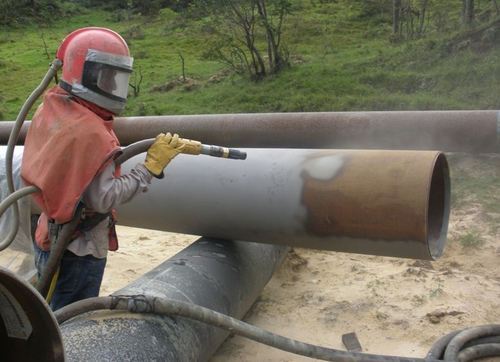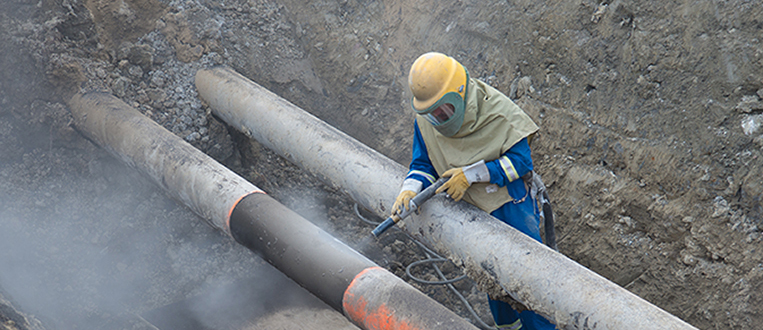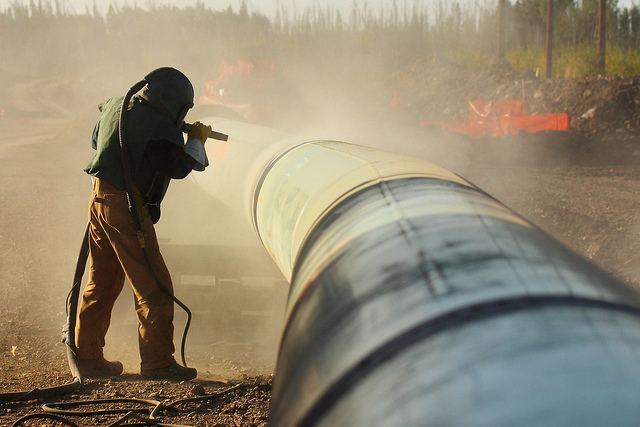Advantages Of Blast Cleaning
It has been indicated by The British Iron & Steel Research Association that surface coating applied to blast cleaned surfaces may be expected to last five times as long as the same surface that had been weathered, then manually wire brushed.

Amplitude – Surface Profile
Amplitude is a measurement (given in microns), that shows the difference between the peaks and troughs in a metal surface produced by blast cleaning. There must be adequate amplitude on the surface of the substrate to ensure good adhesion. However, if the amplitude on the surface is too rough, then there is a risk that the peaks of the blast cleaning process will protrude through the paint film, leading to significantly higher paint consumption or ‘peak rashing’ or spot rusting.

On average, a surface that has been grit blasted should have a profile that lies between 50 to 70 microns, and shot blasted steel under blast primers should be 30 to 50 microns. Profiles in excess of 100 microns should be avoided.
Degreasing before shot sand blasting.
Any surface that is to be blast cleaned and subsequently painted must be thoroughly degreased and cleaned before hand. This should be done using proper Degreasers specified by client. Degreasers must be used in conjunction with an absorbent cloth which must be changed frequently to avoid re-depositing oil / grease onto the substrate. When degreasing, it is necessary to wear adequate personal protection equipment. Refer to relevant Material Safety Datasheets for further information.

Shot/ Grit Blast Cleaning Agents
The surfaces are blast cleaned using one of the abrasives:
- Aluminium Oxide AL2O3 particles.
- Chilled cast iron Particles.
- Chilled Malleable Iron Particles.
- Chiled Steel Particles.
Shot Blasting Requirements
- Pressure of 7 kg/cm² at appropriate distance and angle depending
of nozzle size maintaining constant velocity and pressure. - Chilled cast iron, malleable iron and steel shall be in the form of shot or grit of size not greater than 0.055” maximum in case of steel and malleable iron and 0.04” maximum in case of chilled iron.
- Compressed air shall be free from moisture and oil.
- The blasting nozzles should be venturi style with tungsten carbide or boron carbide as the materials for liners.
- Nozzles orifice may vary from 3/16” to ¾”.
- On completion of blasting operation, the blasted surface shall be clean and free from any scale or rust and must show a grey white metallic lustre.
- Primer or first coat of paint shall be applied within 4 hours of surface preparation.
- Blast cleaning shall not be done outdoors in bad weather without adequate protection or when there is dew on the metal, which is to be cleaned.
- Surface profile shall be uniform to provide good key to the paint adhesion (i.e. 35 to 50 microns).
- If possible vacuum collector shall be installed for collecting the abrasives and recycling.
Blast Cleaning Preparation Grades
It is assumed that prior to treatment the steel surface has been cleaned of dirt and grease, and that the heavier layers of rust have been removed by chipping.
- Sa 1 : Light blast cleaning. Loose mill scale, rust and foreign matter shell be removed. The appearance shall correspond to the prints designated Sa 1.
- Sa 2 : Thorough blast cleaning. Almost all mill scale, rust and foreign matter shall be removed. Finally, the surface is cleaned with a vacuum cleaner, clean dry compressed air or a clean brush. It shall be greyish in colour and correspond in appearance to the prints designated Sa 2.
- Sa 2½ : Very thorough blast cleaning. Mill scale, rust and foreign matter shall be removed to the extent that the only traces remaining are slight stains in the forms of spots or stripes. Finally, the surface is cleaned with a vacuum cleaner, clean dry compressed air or a clean brush. It shall the correspond in
appearance to the prints designated Sa 2½. - Sa 3 : Blast cleaning to pure metal. Mill scale, rust and foreign matter shall be removed completely. Finally, the surface is cleaned with a vacuum cleaner, clean dry compressed air or a clean brush. It shall then have a uniform metallic colour and correspond in appearance to the prints designated in Sa 3.
